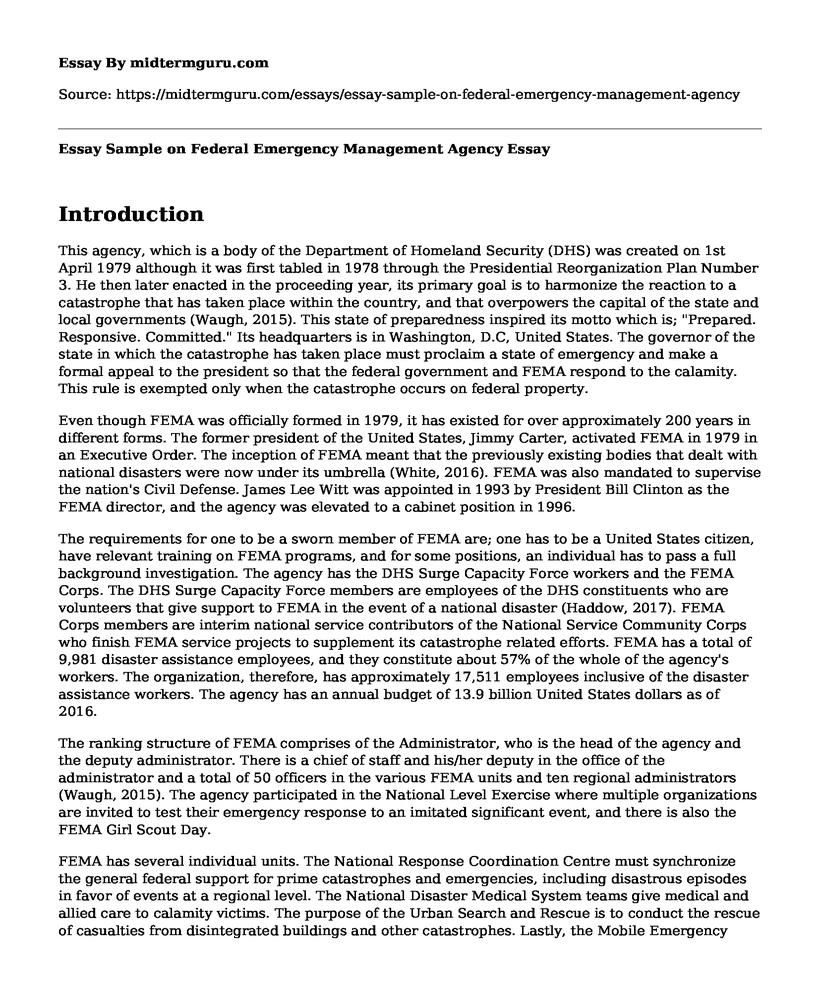Introduction
This agency, which is a body of the Department of Homeland Security (DHS) was created on 1st April 1979 although it was first tabled in 1978 through the Presidential Reorganization Plan Number 3. He then later enacted in the proceeding year, its primary goal is to harmonize the reaction to a catastrophe that has taken place within the country, and that overpowers the capital of the state and local governments (Waugh, 2015). This state of preparedness inspired its motto which is; "Prepared. Responsive. Committed." Its headquarters is in Washington, D.C, United States. The governor of the state in which the catastrophe has taken place must proclaim a state of emergency and make a formal appeal to the president so that the federal government and FEMA respond to the calamity. This rule is exempted only when the catastrophe occurs on federal property.
Even though FEMA was officially formed in 1979, it has existed for over approximately 200 years in different forms. The former president of the United States, Jimmy Carter, activated FEMA in 1979 in an Executive Order. The inception of FEMA meant that the previously existing bodies that dealt with national disasters were now under its umbrella (White, 2016). FEMA was also mandated to supervise the nation's Civil Defense. James Lee Witt was appointed in 1993 by President Bill Clinton as the FEMA director, and the agency was elevated to a cabinet position in 1996.
The requirements for one to be a sworn member of FEMA are; one has to be a United States citizen, have relevant training on FEMA programs, and for some positions, an individual has to pass a full background investigation. The agency has the DHS Surge Capacity Force workers and the FEMA Corps. The DHS Surge Capacity Force members are employees of the DHS constituents who are volunteers that give support to FEMA in the event of a national disaster (Haddow, 2017). FEMA Corps members are interim national service contributors of the National Service Community Corps who finish FEMA service projects to supplement its catastrophe related efforts. FEMA has a total of 9,981 disaster assistance employees, and they constitute about 57% of the whole of the agency's workers. The organization, therefore, has approximately 17,511 employees inclusive of the disaster assistance workers. The agency has an annual budget of 13.9 billion United States dollars as of 2016.
The ranking structure of FEMA comprises of the Administrator, who is the head of the agency and the deputy administrator. There is a chief of staff and his/her deputy in the office of the administrator and a total of 50 officers in the various FEMA units and ten regional administrators (Waugh, 2015). The agency participated in the National Level Exercise where multiple organizations are invited to test their emergency response to an imitated significant event, and there is also the FEMA Girl Scout Day.
FEMA has several individual units. The National Response Coordination Centre must synchronize the general federal support for prime catastrophes and emergencies, including disastrous episodes in favor of events at a regional level. The National Disaster Medical System teams give medical and allied care to calamity victims. The purpose of the Urban Search and Rescue is to conduct the rescue of casualties from disintegrated buildings and other catastrophes. Lastly, the Mobile Emergency Response Support dispenses transmissions reinforcement to the local public safety. The team may control a lorry with satellite transmission at a particular area next to a calamity so that the respondents can communicate with people in unaffected areas.
References
Waugh, W. L. (2015). Living with Hazards, Dealing with Disasters: An Introduction to Emergency Management: An Introduction to Emergency Management. Routledge.
White, C. M. (2016). Social media, crisis communication, and emergency management: Leveraging Web 2.0 technologies. CRC press.
Haddow, G., Bullock, J., & Coppola, D. P. (2017). Introduction to emergency management. Butterworth-Heinemann.
Cite this page
Essay Sample on Federal Emergency Management Agency. (2022, Nov 01). Retrieved from https://midtermguru.com/essays/essay-sample-on-federal-emergency-management-agency
If you are the original author of this essay and no longer wish to have it published on the midtermguru.com website, please click below to request its removal:
- My Greatest Crucible
- Leadership Development Plan - Paper Example
- Essay on Promoting Health Quality in Organization Culture
- Paper Example on Group Conflict
- Paper Example on Critical Theory Approach
- Essay Sample on Negative Effects of Fresh Flowers Production
- Leaders vs Managers: Who Steers the Sports Industry? - Essay Sample







